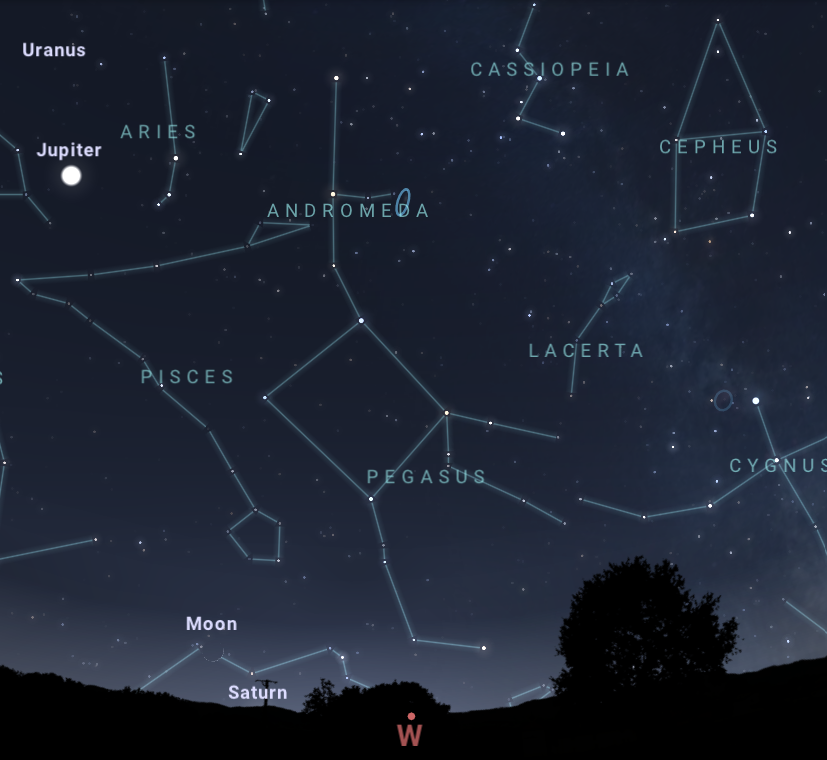Perhaps everyone has heard about the Andromeda Nebula. It gets its name because it is located in the corresponding constellation. In Ukraine, it never goes over the horizon and besides, it is quite easy to find it in the sky. And anyway, there is a lot to tell about it.

1. How to find the Andromeda constellation?
The Andromeda constellation is very visible in the night sky. You can find it, for example, with the help of the Cassiopeia next to it: two sharp corners of the letter “M” point exactly at it. Although another option is also possible.
We should start by searching for the Pegasus constellation. Its bright stars form an almost regular quadrangle. On winter evenings, it is located high above the western horizon. You need the northeastern (upper) star. A chain of three stars stretches higher from it. This is Andromeda.
2. Who is Andromeda?
The Andromeda constellation got its name back in ancient times. According to the myths of Ancient Greece, this was the name of the daughter of King Cepheus. Her mother Cassiopeia carelessly boasted that the princess was more beautiful than the nymphs, and for this the gods sent a sea monster to the kingdom. And the only way to get rid of it was by giving it Andromeda to eat.
However, the end of this story is quite happy. The hero Perseus, having experienced many adventures, finally got on the winged horse Pegasus to the rock to which the girl was chained, and saved her. She later became his wife.
3. Which stars in the Andromeda constellation are the brightest?
There are three brightest stars in Andromeda, forming a chain that stretches from Pegasus and according to which this constellation is mainly known. They are called Alferaz, Mirakh and Alamak. Respectively — α, β and γ of this constellation.
Alferaz is actually a system consisting of two white stars located 97 light years away from us. Both are larger than the Sun and orbit each other in 97 days. The luminary is also interesting because it contains an unusual amount of mercury and manganese.
Mirakh is a red giant about 20 times larger than the Sun and located 200 light years away from us. In 2023, a satellite was found near it, which is most likely a brown dwarf.
The Alamak system is 350 light-years away from us. Its main component is an orange giant. Together with the rest of the components, it orbits around a common center of mass. In addition to it, the system also includes a white and two blue stars.
4. What is interesting about the υ Andromedae system?
One of the most notable objects in the Andromeda constellation is its star υ (read “epsilon”). It is barely visible from the Earth, but nevertheless it is extremely interesting. Firstly, it is a double one. The main component is 27 percent heavier than the Sun and slightly hotter than it. The second is a red dwarf, which has a mass five times less than the Sun and rotates at a distance of 750 AU from the main star.
But that’s not what makes υ Andromedae interesting. It is the first main sequence star to have a multi-planetary system discovered. The first world orbiting the main star of the system was discovered back in 1996. It has its own name Saffar and is a hot Jupiter, which is about 70 percent more massive than the largest planet in the Solar System. It orbits the star in only 4.6 Earth days.
Two more planets in the υ Andromedae system were found in 1999. They both turned out to be gas giants too. The first of them, called Sam, is 14 times more massive than Jupiter and orbits the star in 241 days.
The third planet, called Myriti, is about ten times more massive than Jupiter and orbits the star in 1,276 days. But that’s not all. In 2010, scientists announced that they had found a fourth planet in the system, with a mass like that of the largest world in the Solar System. However, its existence has not been confirmed in the future.

5. What is the Andromeda Nebula?
The Andromeda Nebula is the most visible deep space object from Earth, which is in this constellation. To find it, you need to start with Mirakh (the middle of the three stars) and move towards Cassiopeia. First you will come across a dim star, and then a very pale spot of featureless outlines.
This is the Andromeda Nebula, which is not really a nebula because it does not consist of dust and gas. It got its name at a time when people did not yet know what kind of object it was. It was only in the 19th century that scientists established that the composition of this object, with the designation M31, or Messier 31, includes stars. And in 1923, American astronomer Edwin Hubble proved that the Andromeda Nebula is located outside the Milky Way and is the nearest large galaxy to us.
Follow us on Twitter to get the most interesting space news in time
https://twitter.comne/ust_magazi


